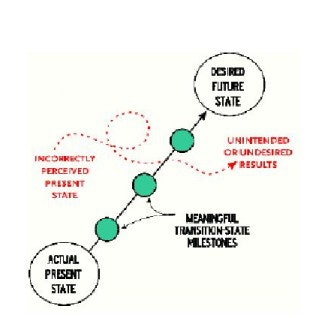
The thriving mind is focused, confident and purpose-driven. By contrast the surviving mind is scattered, worried and opportunistic.
The surviving mind creates barriers to progress and success. It entangles itself in a web of stagnation and frustration — doing things the way they've always been done, or making only minimal improvements. It is, in short, merely surviving.
The thriving mind lives the principle of doing the right things for the right reasons. Consequently, it avoids mediocrity in exchange for meteoric results. By reading AQUA, you are encouraging a thriving mind by seeking new knowledge. It means you are experimenting, innovating and hopefully enjoying work. The thriving mind asks, "What if?" and, "How can I make it happen?" It sees obstacles as opportunities and craves creativity. It engages all resources to build thriving businesses capable of maximum productivity with minimum effort, while withstanding the toughest of challenges.
Amazingly, the states of thriving or surviving are almost equally easy to fulfill — the difference between them being defined by your own mind-set.
THE SURVIVING MIND-SET
You need to get unstuck and start thriving if you:
- Chase random, short-term opportunities.
- Overvalue yourself, and ignore input.
- Confuse activities with results.
- Spend money on the wrong things in the wrong way, creating perpetually unsolved problems.
- Limit your growth and discourage change.
THE THRIVING MIND-SET
You are fostering a thriving mind when you:
- Focus on the longer-term and pursue your future state.
- Don't take yourself too seriously.
- Focus on results, not activities.
- Pay for what you need, not what you can "afford."
- Educate yourself and embrace innovation.
FOCUS ON THE LONGER-TERM
Japanese corporate strategies often span decades. Compare that with American desires for instant gratification: fast food, buy now – pay later, 24-hour shopping. Building a thriving business demands time, commitment, consistency and accountability. Likewise, selling short your company's future state for random, shortterm opportunities all but guarantees mediocrity.
Getting started on a longer-term strategic plan is easier than you think, and much easier than grinding through a traditional business plan development process. Consider holding a future-state workshop, designed along these guidelines:
1. Schedule two days, out of the office, with key personnel.
2. Reserve a meeting room at a hotel and have meals brought in. Have plenty of white boards and colored markers, paper and pens available.
3. Spend the first day defining ground rules for the workshop to provide structure, and conduct a noholds-barred review of your company's present state (where you are), and what you envision for your future state (where you want to be). Focus on solving solid, long-term strategic issues. Outline potential transition-state milestones (steps from your present to future state) that might be needed to get you from your present state to your future state. Now sleep on it.
4. Spend the second day defining, detailing, and mutually agreeing to the transition milestones necessary for achieving your future state.
5. Begin immediate execution of milestone tasks.
Today: Schedule the meeting room. Do not cancel for any reason. You must accomplish this task to find enduring, peaceful success. Need help holding the workshop. E-mail or call me and we'll work on it together.
DON'T BE TOO SERIOUS
History and heroes are two great teachers. I have complete admiration for our nation's World War II fighting forces — men and women of the "The Greatest Generation." My own grandfather went ashore at Normandy. Another of my lifelong heroes of that era is Col. James M. Stewart, an Army Air Corps bomber pilot who was inducted as an enlisted man in 1941 at age 32 — a full decade older than most. He went on to .y 20 successful bombing missions over Europe. Following the war, he entered the Reserves, retiring in 1968 as a brigadier general.
His unwavering patriotism and unmatchable easy demeanor won him individual recognition by Winston Churchill and Harry Truman, among others. He was decorated with the Distinguished Flying Cross, the Air Medal, the Distinguished Service Medal, six Bronze Service Stars, the French Croix de Guerre and made the Sept. 24, 1945, cover of LIFE magazine. In 1985 Ronald Reagan awarded him America's highest civilian award, the Presidential Medal of Freedom.
Col. Stewart was a genuine hero of WWII. Nevertheless, he never took himself too seriously, never walked with arrogance and never considered himself more important than others. He invited input and made changes when better ideas were presented. We must each do the same, and become leaders that others will follow with enthusiasm.
Today: Invite input from a customer, a vendor or an employee. Instead of trying to "manage" customers, let customers manage relationships and sell them first their needs and second their wants. Meeting needs first strengthens relationships and builds lasting loyalty.
FOCUS ON RESULTS
There is a monumental mind-set difference between "being busy" and being productive .
Being busy is easy. It also wastes time, money and opportunities for innovation. It is measured in hours clocked and papers pushed. By contrast, being productive is measured by positive financial results due to optimum time usage and completing meaningful objectives.
When you are productive you work intelligently to create additional disposable time (time you choose how to use), enhance relationships, innovate, fulfill strategies and improve profits. The thriving mind is productive and does not confuse meaningless busyness with measurable results.
Today: Eliminate unnecessary tasks from your schedule. Stop putting out fires and focus on not letting fires start in the first place. I call this "retiring the fire truck."
PAY FOR WHAT YOU NEED
Paying for what you need as opposed to what you think you can afford is similar to "you get what you pay for," except that it addresses a frequent psychological barrier. The misperception of what you can afford leads to under-buying a solution to a problem. The solution you need might be a larger truck to transport more materials, a more innovative and immersive Web site to enhance customer relations, or an individual with specific skills to lead part of your business.
Failing to purchase what you need to fully solve the problem diminishes your company's ability to thrive. And, since a portion of the problem still exists, it will continue to be an issue. Correctly solving a problem produces returns in excess of costs, thereby actually making the purchase affordable. For example, if you need a person with particular skills for a specific job, and that type of person costs $80,000 per year, then it is unreasonable to hire for less than that and expect complete success. The same applies to every other need, including vehicles, equipment, business locations and strategy consultants.
Today: Resolve lingering, strategic purchase decisions immediately. Indecision and delays waste enough money to cover the difference of just solving the problem correctly in the first place.
EDUCATION AND INNOVATION
I read relentlessly, covering nearly 100 books a year, along with hundreds of articles across dozens of industries and topics. Why do I do this. Because there is no value in reinventing the wheel! Do not let lack of knowledge lead you to redevelop something that has already been done. Instead, combine existing knowledge to create new innovations.
Reading engages the mind, encourages new knowledge connections and enables unprecedented forward action. In addition, the more you read, the faster you improve your reading skills, and the more information you will be able to assimilate and apply.
Today: Go to the book review section of my Web site (strategicplanet.com/books), find a title that interests you, then find it at your library or buy it right now.
THE COLONEL AND MR. SMITH
Col. Stewart could have avoided service altogether — the Army rejected him after his first physical for being underweight for his 6-feet, 4-inches. But the determined patriot re-volunteered and was able to convince the draft board to accept him.
Further favoring him was the fact that he was already an international celebrity. He was the same Jimmy Stewart whose acting credits by the time he enlisted included Philadelphia Story , for which he had just won the Oscar for Best Actor, and Frank Capra's Mr. Smith Goes to Washington . Stewart and his personal favorite, It's a Wonderful Life , are still considered among the top actors and movies of all time. As with the Army, he received countless awards, including an Oscar for Lifetime Achievement and a star on Hollywood's Walk of Fame.
Yet, he never took himself too seriously and always stated that his military experience was his greatest life achievement. He kept life simple and avoided the trappings of prestige and money. Did he survive. Absolutely! But he did much more than that. Jimmy Stewart had the mind-set that enabled him to thrive.
Take one hour right now: Focus and act on each of the five "today" tasks I have presented. You will experience instant results and begin thriving at new levels of success.
I live what I write and invite your immediate feedback on this article at strategicplanet.com/aqua. While there, enter to win one of 20 DVD copies of the classic It's a Wonderful Life , starring Jimmy Stewart. We will also send you Fuller/Maynes' "Future State Workshop" organization guide.







































